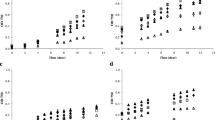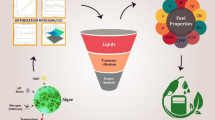Abstract
We hypothesize that, in algae, carbon allocation to lipids depends on the combined effects of the metabolic constraints imposed by the genotype (i.e., species-specific differences in composition) and on the acclimation responses (phenotype) to changes in the stoichiometry of available inorganic carbon (for photosynthesis) and nitrogen (primarily for amino acids, protein, and nucleic acid synthesis). We thus cultured three taxonomically distinct algae, the green alga Dunaliella salina, the diatom Thalassiosira pseudonana, and the dinoflagellate Protoceratium reticulatum, at four nitrate concentrations and constant inorganic carbon. Since energy availability also directly impacts carbon partitioning, we studied the effect of irradiance on the oil quality of P. reticulatum. We used Fourier transform infrared (FTIR) spectroscopy to study carbon allocation and biomass reduction level and gas chromatography for fatty acid analysis. The fatty acid complements of the three species were different; within each species, growth conditions substantially altered oil quality. We ranked the oils in terms of their suitability as biodiesels, using international standards as reference. We believe that this approach may help to identify the appropriate combination of taxa and culture conditions for algal biodiesel production and in general offers insight on carbon allocation to fatty acids.



Similar content being viewed by others
References
Allen CAW, Watts KC, Ackman RG, Pegg MJ (1999) Predicting the viscosity of biodiesel fuels from their fatty acid ester composition. Fuel 78:1319–1326
Baba M, Shiraiwa Y (2013) Biosynthesis of lipids and hydrocarbons in algae. In: Dubinsky Z (ed.) Photosynthesis, InTech, doi: 10.5772/56413
Bamgboye AI, Hansen AC (2008) Prediction of cetane number of biodiesel fuel from the fatty acid methyl ester (FAME) composition. Int Agrophys 22:21–29
Bligh EG, Dyer WJ (1959) A rapid method of total lipid extraction and purification. Can J Biochem Physiol 37:911–917
Blin J, Brunschwig C, Chapuis A, Changotade O, Sidibe SS, Noumi ES, Girard P (2013) Characteristics of vegetable oils for use as fuel in stationary diesel engines—towards specifications for a standard in West Africa. Renew Sust Energ Rev 22:580–597
Choi G-G, Kim B-Y, Ahn C-Y, Oh H-M (2011) Effect of nitrogen limitation on oleic acid biosynthesis in Botryococcus braunii. J Appl Phycol 23:1031–1037
Edwards KF, Thomas MK, Klausmeier CA, Litchman E (2012) Allometric scaling and taxonomic variation in nutrient utilization traits and maximum growth rate of phytoplankton. Limnol Oceanogr 57:554–566
Fanesi A, Raven JA, Giordano M (2014) Growth rate affects the responses of the green alga Tetraselmis suecica to external perturbations. Plant Cell Environ 37:512–519
Flynn KJ, Garrido JL, Zapata M, Opikl H, Hipkin CR (1992) Changes in fatty acids, amino acids and carbon/nitrogen biomass during nitrogen starvation of ammonium- and nitrate-grown Isochrysis galbana. J Appl Phycol 4:95–104
Giordano M (2013) Homeostasis: an underestimated focal point of ecology and evolution. Plant Sci 211:92–101
Goss R, Wilhelm C (2010) Lipids in Algae, Lichens and Mosses. Advances in Photosynthesis and Respiration, 30:117–137
Griffiths MJ, Harrison STL (2009) Lipid productivity as a key characteristic for choosing algal species for biodiesel production. J Appl Phycol 276:23–25
Guschina IA, Harwood JL (2006) Lipids and lipid metabolism in eukaryotic algae. Prog Lipid Res 45:160–186
Harrington KJ (1986) Chemical and physical properties of vegetable oil esters and their effect on diesel fuel performance. Biomass 9 (1):1–17
Hockin NL, Mock T, Mulholland F, Kopriva S, Malin G (2012) The response of diatom central carbon metabolism to nitrogen starvation is different from that of green algae and higher plants. Plant Physiol 158:299–312
Hu Q, Sommerfeld M, Jarvis E, Ghirardi M, Posewitz M, Seibert M, Darzins A (2008) Microalgal triacylglycerols as feedstock for biofuel production: perspectives and advances. Plant J 54:621–639
Jebsen C, Norici A, Wagner H, Palmucci M, Giordano M, Wilhelm C (2012) The FTIR spectra of algal species can be used as physiological fingerprints to assess their actual growth potential. Physiologia Plantarum, 146:427–438, doi: 10.1111/j.1399-3054.2012.01636.x;
Kaffes N, Thoms S, Trimborn S, Rost B, Richter K-U, Köhler A, Norici A, Giordano M (2010) Carbon and nitrogen fluxes in the marine coccolithophore Emiliania huxleyi grown under different nitrate concentrations. Journal of Experimental Marine Biology and Ecology 393:1–8. doi: 10.1016/j.jembe.2010.06.004.
Klyachko-Gurvich GL, Tsoglin LN, Doucha J, Kopetskii J, Shebalina (Ryabykh) IB, Semenenko VE (1999) Desaturation of fatty acids as an adaptive response to shifts in light intensity. Physiol Plant 107:240–249
Klopfenstein WE (1985) Effect of molecular weights of fatty acid esters on cetane numbers as diesel fuels. Journal of the American Oil Chemists Society 62 (6):1029–1031
Knothe G (2007) Some aspects of biodiesel oxidative stability. Fuel Proc Technol 88(7):669–677
Lomas MW, Gilbert PM (2000) Comparison of nitrate uptake, storage, and reduction in marine diatoms and flagellates. J Phycol 36:903–913
Montechiaro F, Giordano M (2010) Compositional homeostasis of the dinoflagellate Protoceratium reticulatum grown at three different pCO2. J Plant Physiol 167:110–113
Montechiaro F, Hirschmugl C, Raven JA, Giordano M (2006) Homeostasis of cell composition during prolonged darkness. Plant Cell Environ 29:2198–2204
Monyem A, van Gerpen JH (2001) The effect of biodiesel oxidation on engine performance and emissions. Biomass Bioenergy 20:317–325
Moser BR, Haas MJ, Winkler JK, Jackson MA, Erhan SZ, List GR (2007) Evaluation of partially hydrogenated methyl esters of soybean oil as biodiesel. Eur J Lipid Sci Technol 109:17–24
Norici A, Bazzoni AM, Pugnetti A, Raven JA, Giordano M (2011) Impact of irradiance on the C al location in the coastal marine diatom Skeletonema marinoi Sarno and Zingone. Plant Cell Environ 34:1666–1677
Ota M, Kato Y, Watanabe H, Watanabe M, Sato Y, Smith RL Jr, Inomata H (2009) Fatty acid production from a highly CO2 tolerant alga, Chlorocuccum littorale, in the presence of inorganic carbon and nitrate. Bioresour Technol 100:5237–5242
Palmucci M, Giordano M (2012) Is cell composition related to the phylogenesis of microalgae? An investigation using hierarchical cluster analysis of Fourier transform infrared spectra of whole cells. Environ Exp Bot 75:220–224
Palmucci M, Ratti S, Giordano M (2011) Ecological and evolutionary implications of carbon allocation of marine phytoplankton as a function of nitrogen availability: a Fourier transform infrared spectroscopy approach. J Phycol 47:313–323
Pandey A, Lee D-J, Chisti Y, Soccol CR (eds) (2014) Biofuels from algae. Elsevier, Burlington
Peterson GL (1977) A simplification of the protein assay method of Lowry et al. which is more generally applicable. Anal Biochem 83:346–356
Picardo MC, de Medeiros JL, Garcia J, Monteiro M, Moreira Chaloub R, Giordano M, de Queiroz Fernandes Araujo O (2013) A methodology for screening of microalgae as a decision making tool for energy and green chemical process applications. Clean Technol Environ Pol 15:275–291
Ramírez-Verduzco LF, Rodríguez-Rodríguez JE, del Rayo Jaramillo-Jacob A (2012) Predicting cetane number, kinematic viscosity, density and higher heating value of biodiesel from its fatty acid methyl ester composition. Fuel 1:102–111
Ramos MJ, Fernández CM, Casas A, Rodríguez L, Pérez A (2009) Influence of fatty acid composition of raw materials on biodiesel properties. Bioresour Technol 100:261–268
Ratti S, Giordano M, Morse D (2007) CO2-concentrating mechanisms of the potentially toxic dinoflagellate Protoceratium reticulatum (Dinophyceae, Gonyaulacales). J Phycol 43:693–701
Schenk PM, Thomas-Hall SR, Stephens E, Marx UC, Mussgnug JH, Posten C, Kruse O, Hankamer B (2008) Second generation biofuels: high-efficiency microalgae for biodiesel production. Bioenergy Res 1:20–43
Solovchenko AE, Khozin-Goldberg I, Didi-Cohen S, Cohen Z, Merzlyak MN (2008) Effects of light intensity and nitrogen starvation on growth, total fatty acids and arachidonic acid in the green microalga Parietochloris incisa. J Appl Phycol 20:245–251
Srivastava A, Prasad R (2000) Triglycerides-based diesel fuels. Renew Sust Energ Rev 4:111–133
Stansell GR, Gray VM, Sym SD (2012) Microalgal fatty acid composition: implications for biodiesel quality. J Appl Phycol 24:791–801
Sun A, Davis R, Starbuck M, Ben-Amotz A, Pate R, Pienkos PT (2011) Comparative cost analysis of algal oil production for biofuels. Energy 36:5169–5179
Acknowledgments
This work was funded by Cariverona Foundation, Italy, by the Italian Ministry for Agriculture (MIPAF, Bioforme project), by the Italian Ministry of Foreign Affairs (MAE, Joint Italian-Israel Cooperation Program), and by the Assemble program of the European Union.
Author information
Authors and Affiliations
Corresponding author
Rights and permissions
About this article
Cite this article
Giordano, M., Palmucci, M. & Norici, A. Taxonomy and growth conditions concur to determine the energetic suitability of algal fatty acid complements. J Appl Phycol 27, 1401–1413 (2015). https://doi.org/10.1007/s10811-014-0457-5
Received:
Revised:
Accepted:
Published:
Issue Date:
DOI: https://doi.org/10.1007/s10811-014-0457-5




